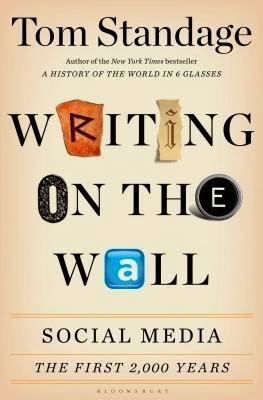Book Review: Writing On the Wall – The First 2000 Years of Social Media
 I’m a fan of Tom Standage‘s earlier works, particularly The Victorian Internet, which explored the parallels between the rise of the telegraph and the rise of the Internet. His latest book, Writing on The Wall: The first 2000 years of Social Media takes a much wider view of the history of social technology and social media.
I’m a fan of Tom Standage‘s earlier works, particularly The Victorian Internet, which explored the parallels between the rise of the telegraph and the rise of the Internet. His latest book, Writing on The Wall: The first 2000 years of Social Media takes a much wider view of the history of social technology and social media.
The big surprise of this excellent book is that the challenges around modern social media that we assume are new have largely been experienced before by different cultures at different times. Back when technologies like the printing press, pamphlets, newspapers, the telegraph and television were the newest innovations, societies struggled to sort out both how to use them and what the cultural implications would be. I found Writing on The Wall to be a palliative in this sense, showing that while Twitter, Facebook and blogging are new in some ways, the questions and opportunities they raise are fascinatingly old and we can benefit by comparing them the impact of inventions of the past.
Concepts like information overload, being distracted by media, trashy reporting and misinformation, and even questioning who should have the right to publish, and to read, come up continually in each era with each new wave of technology, sometimes repeating the patterns of the past (and predicting patterns for the future).
The book proved to be a handy reference in my recent presentation at Seattle City Hall on “Can Free Speech Survive The Social Media Mob?” It belongs on the same shelf as Say Everything: How Blogging Began and The Influencing Machine (my review), as we have few well written histories useful for modern media creators in informing us of what we can learn from past.
I strongly recommend the book for anyone professionally involved in social media, as to claim expertise without even a basic understanding of previous social medias is to fall into one of the greatest traps of innovation we have: chronocentrism, the blind faith that what it has happening now is unique in all history and that we have nothing to learn from the past (A term I believe Standage himself coined). Standage writes well and the book balances a focus on historical detail with insights into the present.
Here are some choice quotes from the book:
Gossip is an extraordinarily rich source of social intelligence, both about the person speaking and about whoever is being discussed. And because our brains are wired to process just this kind of information, we find exchanging it extraordinarily compelling.
Benjamin Franklin’s first foray into newspaper writing took the form of a series of fourteen letters, supposedly written by a widow named Silence Dogood, which he submitted anonymously to the New-England Courant’s office, and which were enthusiastically published by his unwitting brother. James was furious when sixteen-year-old Benjamin admitted to having written the letters. This tale does not simply illustrate Benjamin’s ingenuity and writing prowess; it also shows how newspapers at the time were open to submissions from anyone, provided they expressed an interesting opinion. Such newspapers consisted in large part of reprinted letters, speeches, and pamphlets, and thus provided a platform by which people could share and discuss their views with others.
The average number of titles published in print in England during the 1630s was 624 a year, but the figure jumped to more than two thousand in 1641 and more than four thousand in 1642. In all, some forty thousand different titles appeared between 1640 and 1660. Assuming an average print run of one thousand, that amounts to forty million copies, at a time when the population of England was about five million. This outbreak of printed material put even Luther’s campaign in the shade.
The social mixing that took place in coffee houses allowed ideas to leap over the boundaries of England’s class system, as the writer John Aubrey observed when he praised the “modern advantage of coffee houses … before which, men knew not how to be acquainted, but with their own relations, or societies.”
The bewildering variety of new voices and formats made it very difficult to work out what was going on. As one observer put it in November 1641, “ofttimes we have much more printed than is true.”
Newspapers also began to distance themselves from their readers in another way. Under the new penny-press model, advertisers were a more important source of revenue than readers. From a business point of view, the goal of a newspaper was now to gather as large a readership as possible in order to provide an audience for advertisements. Readers were no longer seen as participants in a conversation taking place within the newspaper’s pages; instead they had become purely consumers of information and, potentially, of the products and services offered by advertisers.
After a one-hundred-and-fifty-year hiatus during which the person-to-person aspect of media was overshadowed by centralized mass media operating on a broadcast model, the pendulum has swung back.
In many respects twenty-first-century Internet media has more in common with seventeenth-century pamphlets or eighteenth-century coffee houses than with nineteenth-century newspapers or twentieth-century radio and television.

One Response to “Book Review: Writing On the Wall – The First 2000 Years of Social Media”
Pingbacks
[…] Scott Berkun reviews Tom Standage’s book, “Writing on the Wall: The First 2,000 Years of Social Media.” […]